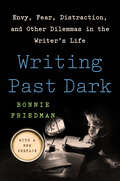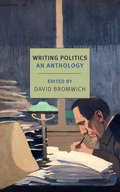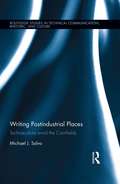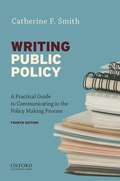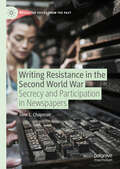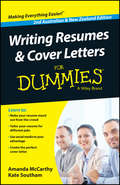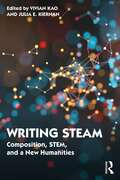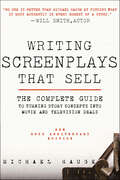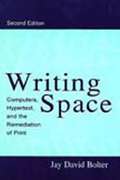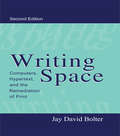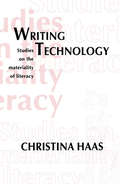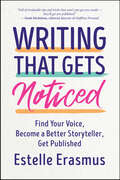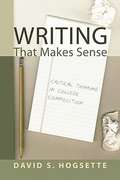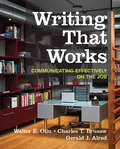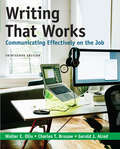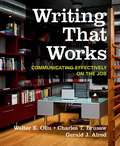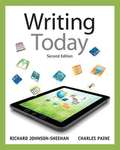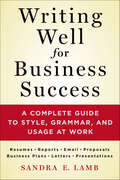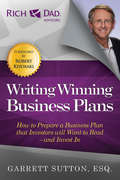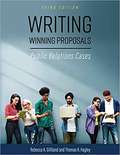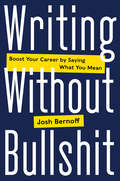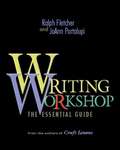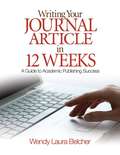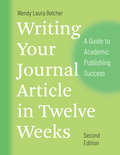- Table View
- List View
Writing Past Dark: Envy, Fear, Distraction and Other Dilemmas in the Writer's Life
by Bonnie FriedmanWriting Past Dark charts the emotional side of the writer's life. It is a writing companion to reach for when you feel lost and want to regain access to the memories, images, and the ideas inside you that are the fuel of strong writing. Combining personal narrative and other writers' experiences, Friedman explores a whole array of emotions and dilemmas writers face—envy, distraction, guilt, and writer's block—and shares the clues that can set you free. Supportive, intimate, and reflective, Writing Past Dark is a comfort and resource for all writers.
Writing Politics: An Anthology
by David BromwichExplore the tradition of the political essay with this brilliant anthology.David Bromwich is one of the most well-informed, cogent, and morally uncompromising political writers on the left today. He is also one of our finest intellectual historians and literary critics. In Writing Politics, Bromwich presents twenty-seven essays by different writers from the beginning of the modern political world in the seventeenth century until recent times, essays that grapple with issues that continue to shape history—revolution and war, racism, women&’s rights, the status of the worker, the nature of citizenship, imperialism, violence and nonviolence, among them—and essays that have also been chosen as superlative examples of the power of written English to reshape our thoughts and the world. Jonathan Swift, Edmund Burke, Henry David Thoreau, Harriet Taylor, Abraham Lincoln, George Eliot, W. E. B. Du Bois, Mohandas Gandhi, Virginia Woolf, Martin Luther King, and Hannah Arendt are here, among others, along with a wide-ranging introduction.
Writing Postindustrial Places: Technoculture amid the Cornfields (Routledge Studies in Technical Communication, Rhetoric, and Culture)
by Michael J. SalvoExploring the relationship between postindustrial writing and developments in energy production, manufacturing, and agriculture, Michael J. Salvo shows how technological and industrial innovation relies on communicative and organizational suppleness. Through representative case studies, Salvo demonstrates the ways in which technical communicators formulate opportunities that link resources with need. His book is a supple articulation of the opportunities and pitfalls that come with great change.
Writing Public Policy: A Practical Guide to Communicating in the Policy Making Process (Fourth Edition)
by Catherine F. SmithIn Writing Public Policy, Fourth Edition, Catherine F. Smith presents a general method for planning, producing, assessing, and critically analyzing communications in a variety of real-life public policy contexts and situations. This practical, concise guide is ideal for students preparing forcareers in politics, government, public relations, law, public policy, journalism, social work, public health, or in any role related to public affairs.
Writing Resistance in the Second World War: Secrecy and Participation in Newspapers (Neglected Voices from the Past)
by Jane L. ChapmanThis book aims to extend existing historical, literary and media knowledge of neglected written voices as a form of print participation in the Second World War. Uniquely, it is framed by an awareness of contemporary requirements for both secrecy and deception, which, it is argued, were nevertheless characterised by a rare participatory inclusivity in terms of writers and audiences - that has hitherto only been perceived as a characteristic of ‘citizen’s journalism’ in the internet age. Comparative cases of resistance using newspapers during the Second World War comprise original and clandestine sources from France, Belgium, the Netherlands, Norway, and Britain - analysed for the effect that intelligence and planned deception had on local publications as well as on readers of resistance broadsheets.
Writing Resumes and Cover Letters For Dummies - Australia / NZ (For Dummies Ser.)
by Kate Southam Amanda McCarthyPractical tricks for standing out from the crowd and getting the job you want in the Australian and New Zealand market Applying for jobs in today's tight job market can seem like an overwhelming process. Competition is fierce and employers expect more than ever before from job applicants. With unemployment and redundancies rising, it's simply not a good time to be looking. So how do make yourself stand out? Writing Resumes and Cover Letters For Dummies, Second Australian & New Zealand Edition shows you how to catch a recruiter's attention. Presenting a wealth of sample resumes and cover letters, this handy, easy-to-use guide shows you how to write a killer cover letter, format your resume for online use, use social networking to your advantage, and tailor your resume and cover letters for specific positions and companies. Designed specifically for job hunters in Australia and New Zealand Offers practical tips and advice on crafting a great resume and a perfect cover letter for any kind of position Includes advice on addressing government selection criteria Features ten ways to turn off a recruiter and ten tips for the perfect presentation No matter how tough the job market is, a great resume and cover letter combination will help you get the attention you deserve. Writing Resumes and Cover Letters For Dummies gives you all the tools and tips you need to get noticed—and get your dream job!
Writing STEAM: Composition, STEM, and a New Humanities
by Vivian KaoThis edited collection positions writing at the center of interdisciplinary higher education, and explores how writing instruction, writing scholarship, and writing program administration bring STEM and the humanities together in meaningful, creative, and beneficial ways.Writing professionals are at the forefront of a cross-pollination between STEM (Science, Technology, Engineering, and Mathematics) and the arts and humanities. In their work as educators, scholars, and administrators, they collaborate with colleagues in engineering, scientific, technical, and health disciplines, offer new degree programs that allow students to bring the humanities to bear on design experiments, and build an academic culture that promotes a vision of the humanities in the twenty-first century, as well as a vision of technology that is decidedly human. This collection surveys and promotes that work through chapters focused on writing instruction, writing scholarship, and writing program administration, covering topics that include data-driven writing courses, public science communication, non-traditional college students, creative writing, gamification, skills transfer, and Writing Across the Curriculum programs. Writing STEAM will be essential reading for scholars, instructors, and administrators in writing studies, rhetoric and composition, STEM, and a variety of interdisciplinary programs; it will aid in teacher training for both humanities and STEM courses focused on writing and communication.
Writing Screenplays That Sell: The Complete Guide to Turning Story Concepts into Movie and Television Deals
by Michael HaugeFor more than twenty years, Writing Screenplays That Sell has been hailed as the most complete guide available on the art, craft, and business of writing for movies and television. Now fully revised and updated to reflect the latest trends and scripts, Hollywood story expert and script consultant Michael Hauge walks readers through every step of writing and selling successful screenplays. If you read only one book on the screenwriter's craft, this must be the one.
Writing Space: Computers, Hypertext and the Remediation of Print (2nd edition)
by Jay David BolterWhen Bolter (Georgia Institute of Technology) finished the first edition in the early 1990s, the World Wide Web was only a couple years old and was still used primarily by research centers and universities. Changes in the technology, the use of it, and the perception of it has convinced him to shift the focus of the second edition to show how hypertext and other forms of electronic writing refashion the forms and genres of print.
Writing Space: Computers, Hypertext, and the Remediation of Print
by Jay David BolterThis second edition of Jay David Bolter's classic text expands on the objectives of the original volume, illustrating the relationship of print to new media, and examining how hypertext and other forms of electronic writing refashion or "remediate" the forms and genres of print. Reflecting the dynamic changes in electronic technology since the first edition, this revision incorporates the Web and other current standards of electronic writing. As a text for students in composition, new technologies, information studies, and related areas, this volume provides a unique examination of the computer as a technology for reading and writing.
Writing Technology: Studies on the Materiality of Literacy
by Christina HaasAcademic and practitioner journals in fields from electronics to business to language studies, as well as the popular press, have for over a decade been proclaiming the arrival of the "computer revolution" and making far-reaching claims about the impact of computers on modern western culture. Implicit in many arguments about the revolutionary power of computers is the assumption that communication, language, and words are intimately tied to culture -- that the computer's transformation of communication means a transformation, a revolutionizing, of culture. Moving from a vague sense that writing is profoundly different with different material and technological tools to an understanding of how such tools can and will change writing, writers, written forms, and writing's functions is not a simple matter. Further, the question of whether -- and how -- changes in individual writers' experiences with new technologies translate into large-scale, cultural "revolutions" remains unresolved. This book is about the relationship of writing to its technologies. It uses history, theory and empirical research to argue that the effects of computer technologies on literacy are complex, always incomplete, and far from unitary -- despite a great deal of popular and even scholarly discourse about the inevitability of the computer revolution. The author argues that just as computers impact on discourse, discourse itself impacts technology and explains how technology is used in educational settings and beyond. The opening chapters argue that the relationship between writing and the material world is both inextricable and profound. Through writing, the physical, time-and-space world of tools and artifacts is joined to the symbolic world of language. The materiality of writing is both the central fact of literacy and its central puzzle -- a puzzle the author calls "The Technology Question" -- that asks: What does it mean for language to become material? and What is the effect of writing and other material literacy technologies on human thinking and human culture? The author also argues for an interdisciplinary approach to the technology question and lays out some of the tenets and goals of technology studies and its approach to literacy. The central chapters examine the relationship between writing and technology systematically, and take up the challenge of accounting for how writing -- defined as both a cognitive process and a cultural practice -- is tied to the material technologies that support and constrain it. Haas uses a wealth of methodologies including interviews, examination of writers' physical interactions with texts, think-aloud protocols, rhetorical analysis of discourse about technology, quasi-experimental studies of reading and writing, participant-observer studies of technology development, feature analysis of computer systems, and discourse analysis of written artifacts. Taken as a whole, the results of these studies paint a rich picture of material technologies shaping the activity of writing and discourse, in turn, shaping the development and use of technology. The book concludes with a detailed look at the history of literacy technologies and a theoretical exploration of the relationship between material tools and mental activity. The author argues that seeing writing as an embodied practice -- a practice based in culture, in mind, and in body -- can help to answer the "technology question." Indeed, the notion of embodiment can provide a necessary corrective to accounts of writing that emphasize the cultural at the expense of the cognitive, or that focus on writing as only an act of mind. Questions of technology, always and inescapably return to the material, embodied reality of literate practice. Further, because technologies are at once tools for individual use and culturally-constructed systems, the study of technology can provide a fertile site in which to examine the larger issue of the relationship of culture and cognition.
Writing That Gets Noticed: Find Your Voice, Become a Better Storyteller, Get Published
by Estelle ErasmusSelected as one of the Best Books for Writers by Poets & Writers Successful essayist, columnist, writing instructor, and editor Estelle Erasmus will show you how to find your voice, write stellar pieces, and get published. In real-world, experience-based chapters, she coaches you to: • mine your life for ideas and incubate those ideas • choose the perfect format — essay, op-ed, feature article, and more • research publications and follow editor etiquette • craft a perfect pitch • protect your psyche from rejection • revise your work for maximum impact • deliver what you promise, protect your work, and get paid
Writing That Makes Sense: Critical Thinking In College Composition
by David S. HogsetteWriting That Makes Sense takes students through the basics of the writing process and critical thinking, and it teaches them how to write various types of academic essays they are likely to encounter in their academic careers. Drawing on nearly twenty years of experience in teaching college composition and professional writing, David S. Hogsette combines relevant writing pedagogy and practical assignments with the basics of critical thinking and logical thought to provide students with step-by-step guides for successful writing in academia. Writing That Makes Sense includes many professional essays and articles from a variety of voices often underrepresented in academia today, thus introducing students to a wider intellectual diversity. Students will also benefit from a chapter on information literacy that provides practical tips on engaging the research process and writing research papers.
Writing That Works
by Gerald J. Alred Charles T. Brusaw Walter E. OliuCountless real-world model documents contextualized by clear rhetorical instruction and a focus on professional ethics make Writing That Works the foundational standard for professional writing. More than ever, this streamlined twelfth edition reflects the role of technology in the office and the classroom, showcasing the most current types of business documents online and in print, providing succinct guidelines on selecting the appropriate medium for your document, communication, or presentation, and giving advice on landing and keeping a job in today's economy. Now also available as an e-book, Writing that Works offers robust but accessible coverage at an affordable price.
Writing That Works: Communicating Effectively On The Job
by Gerald Alred Charles Brusaw Walter OliuMore than ever, Writing That Works is the right choice for the most up-to-date coverage of business writing. Real-world model documents are grounded in their rhetorical contexts to guide students in navigating the increasingly complex world of business writing. Now in full-color, the thirteenth edition continues to reflect the central role of technology in the office and the classroom, showcasing the most current types of business documents online and in print, providing succinct guidelines on selecting the appropriate medium for your document, communication, or presentation, and featuring new advice on creating a personal brand as part of a successful job search. Also available as an e-book and in loose-leaf, Writing that Works offers robust but accessible coverage at an affordable price.
Writing That Works: Communicating Effectively On The Job
by Gerald J. Alred Charles T. Brusaw Walter E. OliuCountless real-world model documents contextualized by clear rhetorical instruction and a focus on professional ethics make Writing That Works the foundational standard for professional writing. More than ever, this streamlined twelfth edition reflects the role of technology in the office and the classroom, showcasing the most current types of business documents online and in print, providing succinct guidelines on selecting the appropriate medium for your document, communication, or presentation, and giving advice on landing and keeping a job in today’s economy.
Writing That Works: Communicating Effectively on the Job with 2020 APA and 2021 MLA Updates
by Gerald J. Alred Charles T. Brusaw Walter E. OliuThis ebook has been updated to provide you with the latest guidance on documenting sources in MLA style and follows the guidelines set forth in the MLA Handbook, 9th edition (April 2021).More than ever, Writing That Works is the right choice for the most up-to-date coverage of business writing. Real-world model documents are grounded in their rhetorical contexts to guide students in navigating the increasingly complex world of business writing. Now in full-color, the thirteenth edition continues to reflect the central role of technology in the office and the classroom, showcasing the most current types of business documents online and in print, providing succinct guidelines on selecting the appropriate medium for your document, communication, or presentation, and featuring new advice on creating a personal brand as part of a successful job search. Also available as an e-book and in loose-leaf, Writing that Works offers robust but accessible coverage at an affordable price.
Writing Today
by Richard Johnson-Sheehan Charles PaineWith a clear and easy-to-read presentation, visual instruction and pedagogical support, Writing Today is a practical and useful guide to writing for college and beyond. This text teaches how to transfer their writing skills to careers. By teaching kinds of writing (analyses, reports, proposals, etc. ), strategies for writing (narration, comparison, argumentation, etc. ), and processes for writing (planning, drafting, revising, etc. ), Writing Today provides the writer with tools they can mix and match as needed to respond effectively to many writing situations.
Writing Well for Business Success: A Complete Guide to Style, Grammar, and Usage at Work
by Sandra E. LambSo much of success in business depends on writing well. From résumés to reports, proposals to presentations,Writing Well for Business Success will help you communicate your ideas clearly, quickly and effectively.It will help you: -Distill your message into a well-targeted statement-Ace the elements of style-Write what you want to say in emails, business plans and more-Master the tricks of editing yourselfPresented in author Sandra Lambs lighthearted and easy accessible style, this little book is an essential desk reference guide for the modern working world.
Writing Winning Business Plans
by Garrett SuttonTo win in business requires a winning business plan. To write a winning business plan requires reading Garrett Sutton's dynamic book on the topic. Writing Winning Business Plans provides the insights and the direction on how to do it well and do it right.Rich Dad/Poor Dad author Robert Kiyosaki says, "The first step in business is a great business plan. It must be a page turner that hooks and holds a potential investor. Garrett Sutton's Writing Winning Business Plans is THE book for key strategies on preparing winning plans for both business and real estate ventures.Crisply written and featuring real life illustrative stories, Writing Winning Business Plans discusses all the key elements for a successful plan. Topics include focusing your business vision, understanding your financials and analyzing your competition. Also covered are how to really use your business plan as a tool and how to attract funding for your new or existing businesses.As business plan competitions become more popular around the world Writing Winning Business Plans also discusses how to enter and how to win these ever more lucrative contests.In addition, how to quickly interest a potential investor, also known as the elevator pitch, is explained. And, as opportunities arise around the world, how to present your plan in various countries is explored.Writing Winning Business Plans is the complete compendium for this essential business rite of passage - preparing a winning plan.
Writing Winning Proposals: Public Relations Cases
by Thomas Hagley Rebecca DeemerWriting Winning Proposals: Public Relations Cases teaches students, as well as practitioners, how to conceptualize and write public relations plans and proposals from the perspective of the plan reviewer — typically non-public relations practitioners. <P><P> The process illustrated within the book is designed to win approval from the plan reviewers and to foster a path for award-winning plan writing. The book thoroughly describes components of the plan, and then provides many actual cases to further demonstrate the strategy and thought process behind plan construction. The cases have multiple suggested writing assignments, role plays, and case problems. These help students and practitioners explore progression of plan construction in various avenues where public relations may be required and practiced. Cases highlighting community relations and engagement, media relations, employee relations and empowerment, government relations, crisis management and prevention, risk communication, corporate communication, social media implementation, arts and entertainment, corporate communication, social responsibility, promotional endeavors, and event planning are all included. <P><P> Writing Winning Proposals is ideal for introductory public relations courses, as well as courses in public relations writing, plans, and campaigns. It can also be used as an academic text supplement, a campaigns workbook, or for strategic planning. <P><P> Rebecca A. Gilliland is a distinguished professor of service learning and an associate professor of communication at the University of Indianapolis. A Fulbright Scholar and a Plank Fellow, Professor Gilliland has traveled the United States and around the world in an effort to stay current in the public relations industry while studying her areas of interest. She advises a nationally award-winning student run public relations firm and has taught numerous public relations classes. She has worked abroad and domestically, in sports promotions, corporate public relations, and in the non-profit sector. She is accredited in public relations and earned a doctorate in education with cognates in both public relations and communication studies. <P><P> Thomas R. Hagley is a senior instructor of public relations retired from the University of Oregon’s School of Journalism and Communication. A recipient of the school’s Jonathan Marshall Award for innovative teaching, he has taught more than 50 classes in public relations principles, advanced writing, strategic planning, and campaigns to a total enrollment of more than 1,000 students. His work as an educator was preceded by 30 years of professional experience as an executive with Alumax, Inc., Hill and Knowlton, Inc., his own consulting business, Alcoa, as publications chief for Newport News Shipbuilding and Dry Dock Co., and general assignment/investigative reporter for The Cleveland Plain Dealer.
Writing Without Bullshit: Boost Your Career by Saying What You Mean
by Josh BernoffJoining the ranks of classics like The Elements of Style and On Writing Well, Writing Without Bullshit helps professionals get to the point to get ahead. It’s time for Writing Without Bullshit.Writing Without Bullshit is the first comprehensive guide to writing for today’s world: a noisy environment where everyone reads what you write on a screen. The average news story now gets only 36 seconds of attention. Unless you change how you write, your emails, reports, and Web copy don’t stand a chance.In this practical and witty book, you’ll learn to front-load your writing with pithy titles, subject lines, and opening sentences. You’ll acquire the courage and skill to purge weak and meaningless jargon, wimpy passive voice, and cowardly weasel words. And you’ll get used to writing directly to the reader to make every word count.At the center of it all is the Iron Imperative: treat the reader’s time as more valuable than your own. Embrace that, and your customers, your boss, and your colleagues will recognize the power and boldness of your thinking.Transcend the fear that makes your writing weak. Plan and execute writing projects with confidence. Manage edits and reviews flawlessly. And master every modern format from emails and social media to reports and press releases.Stop writing to fit in. Start writing to stand out. Boost your career by writing without bullshit.
Writing Workshop: The Essential Guide
by Ralph Fletcher Ralph J. Fletcher Joann PortalupiIs the writing workshop the only way to teach writing? No. There are a variety of approaches or programs, but none of them matches the writing workshop when it comes to growing strong writers. That's why, despite the pressures of testing, the writing workshop has endured and even flourished in thousands of schools across the country. Today we face a time when as many as ten million new teachers are entering the profession. It is for these teachers, and others who are unfamiliar with writing workshop, that Ralph Fletcher and JoAnn Portalupi wrote this book - as a way to introduce and explain the writing workshop . . . to reveal what a potent tool the writing workshop can be for empowering young writers. Above all Writing Workshop is a practical book, providing everything a teacher needs to get the writing workshop up and running. In clear language, Fletcher and Portalupi explain the simple principles that underlie the writing workshop and explore the major components that make it work. Each chapter addresses an essential element, then suggests five or six specific things a teacher can do to implement the idea under discussion. There's also a separate chapter entitled "What About Skills," which shows how to effectively teach skills in the context of writing. The book closes with practical forms in the appendixes to ensure that the workshop runs smoothly. Fletcher and Portalupi's twenty-plus years working with teachers have convinced them that there is no better way to teach writing. This important book is the culmination of all their years of effort, a synthesis of their best thinking on the subject.
Writing Your Journal Article in Twelve Weeks: A Guide to Academic Publishing Success
by Wendy Laura BelcherA comprehensive, well-written and beautifully organized book on publishing articles in the humanities and social sciences that will help its readers write forward with a first-rate guide as good company. ' - Joan Bolker, author of Writing Your Dissertation in Fifteen Minutes a Day `Humorous, direct, authentic ... a seamless weave of experience, anecdote, and research. ' - Kathleen McHugh, professor and director of the UCLA Center for the Study of Women Wendy Laura Belcher's Writing Your Journal Article in Twelve Weeks: A Guide to Academic Publishing Success is a revolutionary approach to enabling academic authors to overcome their anxieties and produce the publications that are essential to succeeding in their fields. Each week, readers learn a particular feature of strong articles and work on revising theirs accordingly. At the end of twelve weeks, they send their article to a journal. This invaluable resource is the only guide that focuses specifically on publishing humanities and social science journal articles.
Writing Your Journal Article in Twelve Weeks: A Guide to Academic Publishing Success (Chicago Guides to Writing, Editing and Publishing)
by Wendy Laura Belcher"Wow. No one ever told me this!" Wendy Laura Belcher has heard this countless times throughout her years of teaching and advising academics on how to write journal articles. Scholars know they must publish, but few have been told how to do so. So Belcher made it her mission to demystify the writing process. The result was Writing Your Journal Article in Twelve Weeks, which takes this overwhelming task and breaks it into small, manageable steps. For the past decade, this guide has been the go-to source for those creating articles for peer-reviewed journals. It has enabled thousands to overcome their anxieties and produce the publications that are essential to succeeding in their fields. <p><p>With this new edition, Belcher expands her advice to reach beginning scholars in even more disciplines. She builds on feedback from professors and graduate students who have successfully used the workbook to complete their articles. A new chapter addresses scholars who are writing from scratch. <p><p>This edition also includes more targeted exercises and checklists, as well as the latest research on productivity and scholarly writing. Writing Your Journal Article in Twelve Weeks is the only reference to combine expert guidance with a step-by-step workbook. Each week, readers learn a feature of strong articles and work on revising theirs accordingly. Every day is mapped out, taking the guesswork and worry out of writing. There are tasks, templates, and reminders. At the end of twelve weeks, graduate students, recent PhDs, postdoctoral fellows, adjunct instructors, junior faculty, and international faculty will feel confident they know that the rules of academic publishing and have the tools they need to succeed.
